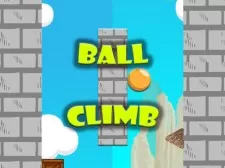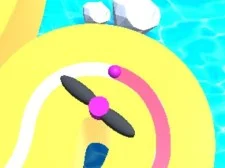Ball Climb

Ball Climb
Master the Ultimate Fast-Paced Obstacle Avoidance Challenge
The Ultimate Climbing Challenge Awaits
Ball Climb represents the pinnacle of fast-paced obstacle avoidance gaming, where split-second decisions and lightning-quick reflexes determine your survival and success. This addictive arcade-style game challenges players to guide a resilient ball through an endless vertical gauntlet of obstacles, testing your ability to think fast, react faster, and climb higher than ever before.
The beauty of Ball Climb lies in its deceptively simple mechanics combined with increasingly challenging gameplay that keeps you coming back for more. Your mission is straightforward yet demanding: navigate your ball left and right along the climbing walls, avoiding obstacles that threaten to end your ascent while pursuing the highest score possible. Each successful dodge brings you closer to climbing glory, while every mistake serves as a learning opportunity to refine your technique.
What sets Ball Climb apart from other obstacle avoidance games is its perfect balance of accessibility and depth. New players can immediately understand the core mechanics and start climbing, while experienced players discover layers of strategy, timing, and precision that separate good climbers from climbing legends. The game’s revive system adds an extra dimension of strategy, allowing players to continue their climb and push for even higher scores.
Mastering the Climbing Mechanics
Movement Control System
Ball Climb employs an intuitive left-right movement system that puts you in complete control of your climbing destiny. Your ball automatically ascends the vertical course, but obstacle avoidance depends entirely on your ability to quickly position yourself in safe zones. The responsive controls ensure that every movement translates immediately to on-screen action, eliminating lag between decision and execution.
Mastering the movement system requires understanding the rhythm of obstacle patterns and developing muscle memory for quick directional changes. Advanced players learn to anticipate obstacle sequences and position themselves strategically, creating smooth climbing flows that maximize both speed and safety.
Obstacle Navigation
The obstacle system in Ball Climb presents constantly evolving challenges that test your reflexes and pattern recognition abilities. Obstacles appear in various configurations, from single barriers requiring quick sidesteps to complex patterns demanding precise timing and positioning. Each obstacle type requires different avoidance strategies, keeping gameplay fresh and mentally engaging.
Understanding obstacle timing and spacing is crucial for developing advanced climbing techniques. Experienced players learn to read obstacle patterns several moves ahead, creating strategic pathways that minimize risk while maintaining climbing momentum.
High Score Optimization Strategies
Achieving high scores in Ball Climb requires more than quick reflexes – it demands strategic thinking, pattern recognition, and precise execution under pressure. The scoring system rewards consistent climbing performance, encouraging players to develop techniques that prioritize both survival and efficiency.
Precision Movement Techniques
High-scoring players master the art of minimal movement, making only the precise adjustments necessary to avoid obstacles. Excessive movement wastes time and increases collision risk, while precise positioning allows for faster climbing speeds and higher scores. Practice making small, controlled movements rather than dramatic position changes.
Develop timing sensitivity by focusing on obstacle approach speeds and creating mental maps of safe zones. Advanced players can predict optimal positioning several obstacles in advance, creating smooth climbing flows that maximize scoring potential.
Score Multiplier Management
Understanding the scoring system’s nuances allows strategic players to maximize point accumulation through consistent performance and risk assessment. Longer survival streaks often result in scoring bonuses, making consistency more valuable than individual spectacular moves. Focus on maintaining steady climbing progress rather than attempting risky maneuvers.
Strategic use of revive options can extend high-scoring runs, but timing these decisions requires careful consideration of current score, remaining obstacles, and personal performance confidence. Save revives for moments when you’re approaching personal bests or have significant scoring momentum.
Mental Focus and Concentration
High score achievement requires sustained mental focus and concentration throughout extended climbing sessions. Develop techniques for maintaining alertness during long runs, such as rhythm breathing, visual focus points, and mental obstacle counting. Fatigue often leads to mistakes, so recognize when concentration starts wavering.
Create pre-game mental preparation routines that put you in optimal focus states. Many top players use visualization techniques, imagining successful climbing sequences and perfect obstacle navigation before starting their attempts.
Quick Reflex Training and Cognitive Benefits
Ball Climb serves as an excellent training ground for developing lightning-fast reflexes and improving overall cognitive performance. The game’s fast-paced nature requires players to process visual information quickly, make rapid decisions, and execute precise movements under time pressure – skills that translate to numerous real-world applications.
Reaction Speed
Improve visual processing and response times through constant obstacle avoidance challenges.
Decision Making
Enhance quick decision-making abilities under pressure through split-second choices.
Visual Tracking
Develop superior visual tracking and peripheral vision awareness skills.
Regular Ball Climb practice systematically improves hand-eye coordination through the constant requirement for precise movement control in response to visual stimuli. Players develop enhanced spatial awareness as they learn to judge distances, speeds, and timing relationships between their ball and approaching obstacles. These improvements in spatial processing often transfer to other activities requiring similar skills.
The game also provides excellent training for sustained attention and focus maintenance under stress. As climbing sessions extend and difficulty increases, players must maintain peak concentration while managing increasing mental pressure. This mental training builds resilience and focus stamina that benefits many aspects of daily life and other skill development activities.
Advanced Climbing Strategies and Techniques
Mastering Ball Climb at the highest levels requires understanding advanced strategies that separate casual players from climbing experts. These techniques involve pattern recognition, predictive positioning, and optimal decision-making under extreme pressure conditions.
Pattern Recognition Mastery
Advanced players develop the ability to recognize recurring obstacle patterns and anticipate upcoming challenges based on previous sequence experience. This skill allows for predictive positioning, where players move to optimal locations before obstacles become immediately threatening. Pattern recognition reduces reactive play and enables proactive strategic positioning.
Study common obstacle sequences during practice sessions, paying attention to spacing, timing, and safe zone locations. Many obstacle patterns repeat with variations, and recognizing these similarities allows for faster decision-making and more confident navigation through challenging sections.
Optimal Path Planning
Expert climbers learn to plan movement paths several obstacles in advance, creating efficient routes that minimize unnecessary movement while maintaining safety margins. This involves understanding how current position affects future options and making strategic sacrifices of ideal positioning to ensure long-term climbing success.
Practice visualizing upcoming obstacle sequences and planning movement chains that flow smoothly from one safe zone to the next. Optimal path planning often involves accepting slightly more challenging positions to set up better opportunities for subsequent obstacles.
Rhythm and Timing Optimization
Developing consistent rhythm and timing allows players to synchronize their movements with obstacle patterns, creating smooth climbing flows that feel almost musical in their precision. This rhythm-based approach reduces mental fatigue and enables longer high-performance climbing sessions.
Practice establishing personal rhythm patterns that match your reflexes and decision-making speed. Many expert players develop signature timing signatures that optimize their natural reaction patterns and minimize the cognitive load of constant decision-making.
Competitive Gaming and Achievement Hunting
Ball Climb’s competitive elements transform individual climbing challenges into exciting competitions against friends, online leaderboards, and personal achievement goals. The game’s scoring system creates natural competitive frameworks that encourage continuous improvement and skill development through friendly rivalry and personal challenge pursuit.
Social Competition
Competing with friends and family members adds social dimension to Ball Climb that enhances motivation and creates shared gaming experiences. Challenge others to beat your high scores, compare climbing strategies, and celebrate achievement milestones together. Social competition often reveals new techniques and approaches you might not discover playing solo.
Create friendly tournaments or challenge leagues with regular score comparisons and achievement celebrations. Many players find that social competition provides additional motivation for practice and improvement beyond personal satisfaction.
Personal Achievement Goals
Setting and pursuing personal achievement goals provides structure and motivation for long-term skill development. Create milestone targets for scores, climbing heights, or consecutive successful runs. Achievement pursuit helps maintain interest during skill development plateaus and provides clear progress markers.
Track your progress over time and celebrate improvements in different skill areas, not just final scores. Many aspects of climbing performance can be measured and improved, from reaction times to consistency ratings to pattern recognition accuracy.
The revive system adds strategic depth to competitive play by introducing resource management decisions. Knowing when to use revives for score maximization versus saving them for future attempts becomes a crucial competitive skill that separates strategic players from purely reactive ones.
Training Variations and Skill Challenges
To maximize skill development and maintain long-term interest in Ball Climb, create custom training variations and specialized challenges that target specific aspects of climbing performance. These focused practice sessions help identify and improve weak areas while preventing monotonous repetition of standard gameplay.
Speed Climbing Challenges
Focus on climbing speed by challenging yourself to reach specific heights in minimum time while maintaining safety. Speed challenges develop quick decision-making and efficient movement patterns. Practice rapid position changes and minimal hesitation between movement decisions.
Time yourself reaching various climbing milestones and work to improve these benchmarks through technique refinement and reaction speed improvement. Speed training often reveals inefficiencies in movement patterns that aren’t apparent during normal gameplay.
No-Revive Climbing
Practice climbing without using revive options to develop conservative, safety-focused strategies that prioritize consistent performance over risk-taking. No-revive challenges force players to develop reliable techniques and better risk assessment skills.
This variation helps build confidence in fundamental climbing abilities and creates appreciation for safety margins. Many players discover that no-revive practice actually improves their overall scoring through more consistent performance.
Peripheral Vision Training
Challenge yourself to maintain focus on specific screen areas while using peripheral vision to track obstacles and safe zones. This training improves visual processing efficiency and develops better spatial awareness during high-speed climbing.
Peripheral vision training often results in smoother, more confident movement patterns as players learn to process visual information more efficiently and react to threats they’re not directly observing.
Complementary Gaming Experiences
After intense Ball Climb sessions, many players benefit from exploring different gaming genres that provide mental contrast while maintaining engagement and skill development. These complementary experiences help prevent gaming fatigue while exercising different cognitive abilities.
Relaxation Gaming
Balance intense climbing sessions with calming, stress-relief gaming experiences. Pop It Fidget games provide perfect mental decompression after high-energy climbing challenges, offering therapeutic repetitive gameplay that helps reset your mental state and reduce accumulated tension.
This contrast between high-intensity and relaxation gaming creates healthy gaming rhythms that prevent burnout while maintaining long-term engagement with both game types.
Creative Expression
Exercise different cognitive muscles through creative gaming that emphasizes design, decoration, and artistic expression. Room decoration games provide excellent creative outlets that engage spatial reasoning and aesthetic decision-making in completely different ways than obstacle avoidance challenges.
Creative gaming experiences often improve overall cognitive flexibility and provide fresh perspectives that can surprisingly enhance your climbing performance through improved visual processing and spatial awareness.
Technical Excellence and Performance Optimization
Ball Climb’s technical implementation ensures consistent, responsive gameplay across all devices and platforms. The game’s optimization prioritizes minimal input lag, smooth frame rates, and reliable performance even during extended gaming sessions or on lower-specification devices.
Cross-Platform Performance
The game maintains identical performance characteristics across desktop computers, tablets, and smartphones, ensuring that skill development translates seamlessly between devices. Touch controls and mouse controls offer equivalent precision and responsiveness, allowing players to maintain their climbing abilities regardless of platform.
Automatic scaling and optimization ensure optimal visual clarity and control precision across different screen sizes and resolutions, maintaining competitive fairness and skill consistency across all supported devices.
Response Time Optimization
Critical for fast-paced gameplay, Ball Climb minimizes input lag and processing delays to ensure that player actions translate immediately to on-screen movement. This optimization is essential for competitive play and high-score achievement where millisecond differences can determine success or failure.
The game’s engine prioritizes control responsiveness over visual effects, ensuring that performance remains consistent even during visually intensive moments or extended play sessions.
Regular performance monitoring and optimization updates ensure that Ball Climb continues to deliver excellent gameplay experiences as devices and browsers evolve. The development team maintains focus on preserving the precise control feel that competitive players depend on for consistent high-level performance.
Begin Your Climbing Journey Today
Ball Climb offers an perfect blend of immediate accessibility and long-term skill development that appeals to casual players seeking quick entertainment and serious gamers pursuing mastery and high-score achievement. The game’s simple mechanics hide surprising strategic depth that reveals itself through dedicated practice and experimentation.
Start Your Adventure
Whether you’re looking for a quick reflex challenge during breaks, a competitive gaming experience to share with friends, or a dedicated skill development journey, Ball Climb provides the perfect platform for fast-paced entertainment and personal achievement.
Begin with basic climbing practice, gradually incorporate advanced techniques, and discover your own climbing style as you pursue higher scores and greater climbing heights. Every climb offers new challenges and opportunities for improvement, ensuring that Ball Climb remains engaging and rewarding throughout your gaming evolution.
Categories and tags of the game : 1player, Clicker, Fast, Quick















